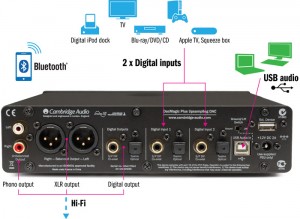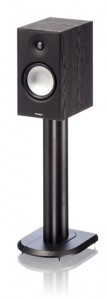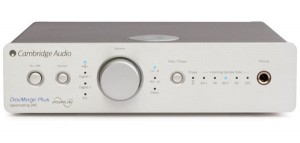Paradigm Studio Series 7 Mini Monitor Loudspeakers $899
Cambridge Audio Azur 651A Integrated Amplifier $1199
Cambridge Audio DacMagic Plus DAC $799
5 Stars
You can’t fudge it with budget, but this combo of Paradigm and Cambridge prove that sometimes paying less gives you just what you need. And more.

Lest we get accused of focusing only on expensive audio gear, it’s time for a look at some budget kit to see just how far components around the thousand-dollar mark can take music lovers. This relatively humble system is made up of equipment from two manufacturers, one Canadian (Paradigm), the other British (Cambridge Audio). I’ve heard equipment from both companies numerous times in the past and have always been impressed by the value for money on offer, especially at the lower end of the respective ranges.
When choosing the components for review here, I could easily have gone with a set of speakers from further up the Paradigm range. Given my slightly intense focus on the “speaker first” philosophy, I’d happily place a set of $5000 speakers on the end of this amp and source but I wanted small and simple, not to mention easy to lug upstairs. So the Mini Monitors from the Series 7 Monitor range, which are the second smallest speakers in Paradigm’s range, were shipped up from local agents PQ Imports in Hamilton. These compact stand mounts are nice looking speakers, especially when set up without the grilles, with that silver/white driver contrasting so well with the black ash finish. Like all budget gear, they’re built to a price, so a knock with a knuckle on the side of the cabinet reveals that the Mini Monitors are far from dead quiet or rock solid but the construction is entirely appropriate for the dollars.
The Cambridge Audio 651A integrated amplifier is the latest in a series that’s been doing the business for ages – from 640 to 650 and now to the 651A – and these amps have evolved with the times. The latest model now boasts a built-in USB Digital to Analogue Converter (DAC) in addition to the usual comprehensive feature list and lengthy specification sheet – 75 watts per channel (into 8 Ohms), dual speaker zones, separate transformer taps for each channel, twin rectifiers and separate power supplies for dual-mono operation of the power amp stages as well as a high grade film type volume pot.

There are five RCA inputs, a 3.5mm input for portable devices, 6.35mm headphone jack, preamp outputs, a subwoofer output and dual recording outputs. A phono stage is missing in action but I daresay that the USB input will be of more use to a greater proportion of owners, so I can’t really quibble here, especially seeing as Cambridge Audio offers some really good high-value external phono stages. The 651A is decently built and fairly solid; it’s no massive metal behemoth with a colossal faceplate but considering the spec sheet and the price, that would be expecting a bit too much.
The DacMagic Plus DAC is a versatile device with a wildly comprehensive specification sheet that almost baffles the brain at the price. It’s a 24 bit/192kHz capable unit featuring twin Wolfson DAC chips and a 384kHz upsampler from Anagram Technologies. There are two 24 bit digital inputs (with optical and coaxial available on each one), balanced XLR and single-ended RCA outputs plus a high-resolution capable asynchronous type USB input. Users even get access to three selectable digital filters, plus there’s an optional external Bluetooth receiver that supports the latest high quality apt-X Codec for those who want a bit of wireless freedom. Quite a list but wait, there’s more, the DacMagic Plus can even be used as a digital preamp allowing direct connection to power amps and active speaker systems.

It may seem counterintuitive to plonk an eight hundred dollar DAC on the end of a twelve hundred buck amp that already has a built-in USB DAC, but that’s not really the case. In the olden times, a CD player would have been the source of choice (I’m not talking about ye most ancient of analogue olden times here) and the matching 651C CD player costs $999. The DacMagic Plus offers far more flexibility than the amp’s built-in USB DAC and it’s also high-resolution capable, which elevates it to another level entirely.
Sound Quality
My listening notes make for interesting reading. When it comes to gear that’s very much in the entry-level range, I don’t generally expect to find comments such as “deeply illuminated midrange” or “superb soundstaging”. Small sub $1000 speakers shouldn’t provoke notes along the lines of “surprising levels of bass extension” or “screeds of detail” but that’s the reaction I had to the Paradigm/Cambridge Audio pair, even when the source was my iPod Classic loaded with 320kbps files feeding a Pro-Ject Dock Box Fi. I’d set up the iPod to simplify running the system in – with 80Gb of music in that tiny drive, I could leave it on shuffle for hours or days and just let everything loosen up in its own good time.
So I was a little taken aback by how good the system sounded from the start. Perhaps the budget nature of the gear or the compressed source files had led me to expect a middling result, but this was anything but. I felt a pressing need to roll out the cliché about components playing at a level above their price points but in all seriousness, I really was hearing an impressive performance and the DacMagic Plus was still in its box.
I’ve been known to stare at metal dome tweeters with a leery glare and I’ve sometimes had a good reason for my distrust, but the behaviour of this 1-inch satin anodised aluminium dome was exemplary, with no harsh metallic tings, zings or bangs and no overly bright sheen masquerading as an increase in overall resolving powers.

With the 651A in the driving seat, the sound of the top end has no fatiguing characteristics, nor is it in the least bit bland. Instead, what edge is there is just enough to add a touch of excitement. It’s not as silky an experience as a good soft dome but listening to the lightly strummed acoustic guitars on Crosby, Stills and Nash’s ‘Tracks in the Dust’ from the four disc CSN box set had me shaking my head with no small degree of wonder; there was a palpable sense of the strings and even the depth of the guitar bodies, while the slow vocal harmonies sounded as clearly delineated as if they were being presented by a well balanced system, capable of carrying a higher price tag (there’s that value for money thing again).
On the other side of the frequency range, a small cabinet and a single moderately sized 6.5-inch woofer aren’t exactly the formula for big time bottom end extension; simple physics dictates that the Mini Monitors can’t reach down to the lowest octaves. According to Paradigm, the Mini Monitors can find their way to 42Hz at -3dB but even in a big room with Massive Attack’s ‘Daydreaming’ from Blue Lines playing, I wasn’t aware of a great void in the low frequencies. Placed well into the room, bass notes were quite tight, there was no sense of the ports chuffing away in the background and the balance was entirely acceptable even without boundary reinforcement.
The Mini Monitors sounded fine on lightweight stands but heavy stands would no doubt tighten the bottom end even further. They only lost some of the sense of air and spaciousness when placed on a deep shelf closer to a wall, but gained some bass weight in return. So Paradigm has engineered this new series very well indeed from what I can tell here (and the previous versions were no slouches either).
The speakers display the expected mini monitor (as in type not model name) virtues – excellent imaging and precise instrument placement, along with plenty of speed and an overall feeling of cohesion and driver integration. They’re definitely at their best with the tweeters at ear height though – if the listener is seated substantially below this level, a noticeable amount of the top end sparkle will be missing in action.

With Cambridge’s DACMagic Plus plugged in and fed by my MacBook Pro, the system really came alive. The original DacMagic was well reviewed all over the world, including no less a luminary than our own Gary Pearce, who bought one for his own system. I’m passing the DacMagic Plus on to Andrew Baker for a full high-resolution review along with Rotel’s brand new DAC, but suffice to say that in this system, the detail levels were noticeably better with the DacMagic Plus in place. The air and space around the performers improved by no small amount even with CD quality files. The recorded acoustic was more real and bass texture more apparent. Tracks with loads of available detail such as Nils Lofgren’s ‘Keith Don’t Go’ from Acoustic Live or ‘Shoot The Lights Out’ from The Watson Twins’ Southern Manners CD really stood out.
Livelier tracks were also elevated and it sounded as if the speaker drivers were reaching just the faintest touch deeper than before, and that there was more attack and energy on hand. Effectively, the music was more involving and it seemed easier to just ignore the equipment and to enjoy the experience.
Trying the 651A’s built-in USB input provided an interesting comparison. It actually sounded quite good, certainly on a par with the enjoyable sound of the Pro-Ject dock, but it wasn’t a match for the DacMagic Plus, nor did I expect it to be. Your $799 buys a substantially more capable and flexible digital source but that said, I’d see no hassle with any new user starting off with the amp and speaker combination and buying a more serious DAC or even a turntable at a later stage when funds allow. You could more than just get by for a while, that’s for sure.
I had no trouble getting either the DacMagic Plus or the 651A DAC up and running. It really is a case of plug and play – at least in the Mac environment – but that’s usually the case and is probably why Mac users are so damn smug.
Conclusion
This system isn’t high end by any means. In the great audiophile scheme of things, it’s distinctly entry level but it genuinely did the business and kept me happy for as long as I had it running, even with humble sources. It was always fun to listen to, with any sins taking place in the realm of omission rather than commission. More scale and sheer grunt in the room wouldn’t go amiss nor would some extra bass weight but that takes additional cabinet volume and reinforcing, along with bigger drivers perhaps, all of which costs more. Higher quality amplification would expand the listening experience in every area but likewise would require increased expenditure. Again, that’s not the point; for the money, this gear is gold, particularly the amp and speakers.
I found myself in the presence of the occasional flash of budget brilliance – long late nights with the volume down playing Van Morrison and the more mellow Led Zeppelin tracks hidden on my hard drive or on neighbor-free mornings with the pedal to the metal and Stevie Ray Vaughan or ZZ Top filling the room. At these times, it seemed that I could live with the system forever and never really want any more. I admit to getting a bit carried away towards the end and digging out my cryogenically treated Slinkylinks silver interconnects and speaker cables, just for kicks, which is when things got really amazing.
One very relaxed Sunday evening, I was slouched down on the couch with CSN’s ‘So Begins the Task’ just flowing into the room and I was convinced for a few splendid minutes that I was in hi-fi nirvana. Then there was a particularly memorable (and loud) session with Mr. John Lee Hooker that just about rewired my brain’s understanding of what budget gear is all about. Yes, the cable price is out of whack with the system (at least in conventional audiophile thinking) but considering that the total value at the front of the room still wasn’t over the $5K mark, that’s quite something to say and even more so to experience.
Even without the Slinkys in place and plain old copper connecting everything, there was some serious system synergy on the go, which is always a joy to hear, and it can take what might be mundane to lofty heights. There’s a magic here that I’ll remember long after the boxes with their bits head back down that highway. A highly, even wildly-recommended combination. ASHLEY KRAMER
















Your review is much appreciated. The DAC MAGIC PLUS is on my short list. It is really full featured. Having had a few Cambridge Audio products in the past I can attest to the good sound. My hope would be that the reliability would be better than my past experience.
Could you please tell how you connected MacBook Pro with DACMagic Plus?
Is there any audio quality drawback when streaming lossless from MacBook Pro to SqueezeBox Touch > DACMagic Plus?